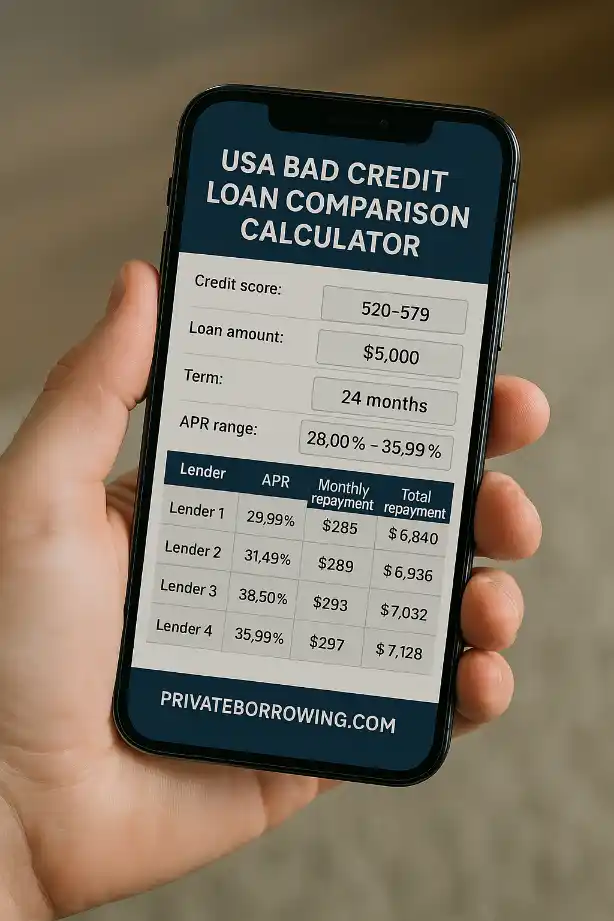
What is a U.S bad-credit loan comparison calculator ?
USA Bad-Credit Loan Comparison Calculator — What Bad-Credit Loans Are, How They Work & How to Compare
A bad-credit loan in the U.S. is financing designed for borrowers with low FICO scores, thin files, or recent credit issues. These loans come from banks, credit unions, and especially non-bank consumer-finance companies (including online lenders and some payday/short-term providers). Pricing is risk-based and can be much higher than prime loans. Responsible options emphasize fixed-rate installments with clear payoff schedules; risky options include single-payment payday loans and costly lines of credit.
How costs work
- APR & fees: Installment lenders quote an APR (often capped in some states). Subprime APRs are higher; always compare total cost.
- Term & payment: Fixed installment loans amortize over a set number of months (e.g., 6–60). Lines of credit have variable payments. Classic payday loans are single-payment and extremely expensive.
- State rules: Availability, limits, and pricing vary by state law. Read each lender’s state “Rates & Terms”.
Types of bad-credit loans
- Installment personal loans (recommended vs. payday): Fixed term, fixed payment; clearer path to payoff.
- Debt-consolidation installment loans: Similar to above, used to combine multiple debts.
- Credit-builder loans: Small amounts or secured savings-style products to build history.
- Lines of credit / short-term: Flexible draws but can be costly; mind fees and compounding.
- Payday/single-payment: Very high cost; consider only if you fully understand the payoff and legal protections.
Do & Don’t when applying
- Do check pre-qualification (soft check) where possible and compare APR + fees + total repayable.
- Do verify the lender’s licensing and read Truth-in-Lending disclosures and state “Rates & Terms”.
- Don’t stack multiple loans or roll over short-term loans—this can spiral costs.
- Don’t pay any advance/“release” fees to get a loan. Legit costs are disclosed and deducted, not wired upfront.
Typical documentation
- Government-issued ID, age 18+
- Social Security Number/ITIN (varies), U.S. address and phone
- Proof of income (recent paystubs or bank statements) and active checking account for ACH
- Consent to credit/bank-data checks; additional documents by state and lender
This page is educational: figures are indicative. Always rely on the lender’s official, state-specific disclosures.
Private Loan Resources
Personal Loan
Without Collateral
U.S. payday-loan comparison
Pay Off Credit Card
Debt Consolidation
Loan For Entrepreneur
Loan For Student
Loan With No Job
Loan Against Property
Loan Against Car
Loan Agreement Template
Private Mortgage
U.S. bad-credit loan comparison
Loan Without Credit Check
Loan Without Bank
Loan For Senior Citizen
Loan Without Guarantee
Private School Loan
Loan For Startup
Loan For Farmer
Loan Scam
Loan Without Interest
Private Microcredit
Cash Donation
Immediate Loan
Halal P2P Loan
Loan Universal Credit
Loan Low Income
Loan SSI Recipient
Loan For Poor People
Loan For Disabled
Loan For Latino
Loan For Women
Loan For Housewife
Loan Without Document
Loan For Trader
Loan Without SSN
Piggyback Loan
Loan For Master’s Degree
Loan For Taxi
Loan With IBV
Loan For Down Payment
List of Private Lenders
Loan For Divorce
No Upfront Fee
Worldwide Lender
Loan United States
Loan Canada
Loan Australia
Loan New Zealand
Loan United Kingdom
Iceland Loan Without Interest
NFBC loan comparison calculator
Loan South Africa
Iceland P2P Loan
Loan China
Japan Lender
Loan Philippines
Loan Mexico
Loan Ireland
Loan Israel
Dubai private loan comparison
South Korea Private Lending
Loan Pakistan
Loan France
Loan Switzerland
Loan Germany
Loan Netherlands
Loan Norway
Loan Sweden
Loan Denmark
Loan Finland
Loan Latvia
Loan Greece
Loan Kenya
Loan Nigeria
Loan Thailand
Loan Spain
Loan Italy
Loan Brazil
Loan Russia
Loan Egypt
Loan California
Loan New York
Loan TANF-SSI
Loan with SRD